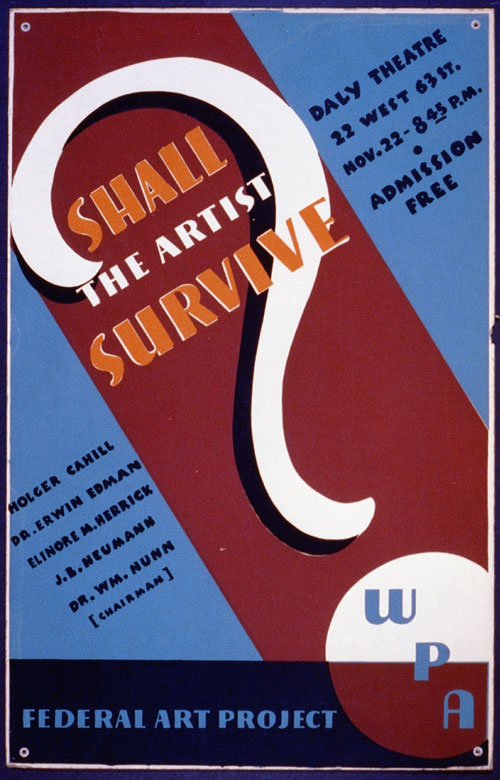A creative mental or physical activity done by artist in order to produce an artwork.
There are three requisite elements that determine production of an artwork: availability of scarce resources, disposition of an environment, and chosen strategies of an actor. The environmental situation for art production might consider high level of uncertainty, as a result of economic or political crises, artists’ precarious working conditions, or instability and hostility of a surroundings. This usually results in high mortality rate of small art initiatives that fails to adapt to the institutional structure of super-ordinate cultural system. Cultural conception of environment indicates that initiatives survive only if they achieve genuine legitimacy within wider society.
“From the perspective of the evolutionary model, one would argue that the environment must have changed to give selective advantage to particular forms at a given time… The purest form of environmental selection is the selective survival or elimination of complete organisations, depending on their fit to the environment. For instance, if the selection were base on administrative rationality, nonbureaucratic organisations might fail to survive, leaving only bureaucracies.” (Aldrich and Pfeffer, Environments of Organisations, 1976)
In contrast to the approach that emphasis the effects of environmental conditions there is “the great man approach”, which focus on the man who acquire a power to modify the environment.
Recommended artwork

enlarge image
Shall the artist survive? Colour silkscreen poster for US Federal Art Project, 1935-1943
Image in the public domain source
In order to relieve effects of the Great Depression in US, Roosevelt’s Works Progress Administration (WPA) started Public Works of Art Project inspired by the Mexican Muralist Movement. The project implied art instruction, art research and art production, i.e., creation of posters, paintings and murals for public buildings. The Federal Arts Program (FAP) was first proposed to Roosevelt by George Biddle, and was developed as the division of the WPA with the goal to employ out-of-work artists. FAP provided over 5,000 jobs for artists (wage was $23 to $35 a week) and produced over 225,000 public artworks for the American people. The hundreds of American artists worked through the WPA, many of them achieved broad recognition such as Mark Rothko, Jackson Pollack, Willem De Kooning, Arshile Gorky, Berenice Abbott, etc.
An example in the ARTS -> “THE ART IN LIQUIDATION / UMETNOST U LIKVIDACIJI”
During the Value Quest, an ARTIST comes to a
RESOLUTION
to undergo a process of liquidation
Upon value-based enterprise the ART, THE LIQUIDATION COMES
INTO PLAY.
The debtors of the ART are called to settle their obligations.
The creditors of the ART are called to file their requests.
A certificate related to debt pay-off and filed claims should be uploaded at: http://valuequest.info/liquidation
The ARTIST is dispensed with the duty of liable agent of the ART. The Value Quest Bourse is appointed as a liquidator.
Rationale
The ARTIST undergoes the process of liquidation upon the ART due to the suspension of natural requirements to conduct this value-based enterprise.
Belgrade, October 2011.
U okviru Potrage za vrednošću, UMETNIK donosi
ODLUKU
o pokretanju postupka likvidacije
Nad vrednosnom delatnošću UMETNOST, POKREĆE SE POSTUPAK LIKVIDACIJE.
Pozivaju se dužnici da izmire svoje obaveze prema UMETNOSTI.
Pozivaju se poverioci UMETNOSTI da prijave svoja potraživanja.
Potvrde o izmirenim dugovanjima i prijave potraživanja dostavljaju se na adresu: http://valuequest.info/liquidation
UMETNIK se razrešava funkcije zakonskog zastupnika UMETNOSTI. Za likvidacionog upravnika imenuje se Value Quest Berza.
Obrazloženje
UMETNIK pokreće postupak likvidacije nad vrednosnom delatnošću UMETNOST iz razloga prestanka prirodnih uslova za obavljanje delatnosti.
Beograd, Oktobra 2011.
REF 1 -> A resolution The Art in Liquidation passed by an Artist within 52th October Salon in Belgrade (2011), marks an anniversary of UNESCO’s Recommendation concerning the Status of the Artist proceed in Belgrade (October, 1980). On the basis of the importance that art has in a society, the recommendation displays the regard accorded to artists and gives recognition of the “artist’s liberties and rights, including moral, economic and social rights, with particular reference to income and social security, which artists should enjoy.” The General Conference of the United Nations Educational, Scientific and Cultural Organisation, meeting in Belgrade from 23 September to 28 October 1980 at its twenty-first session.
REF 2 -> Viminacium Declaration (September, 2011): ”We hereby declare that we shall: Recognize and promote the essential role of the arts in the life and development of individuals and society at large, and accordingly respect and assist artists in their freedom of creation and expression, their dignity and their integrity in describing, capturing and interpreting changing conditions of the contemporary globalizing world.” The Heads of State of South-East European countries, met at the Roman archeological site of Viminacium in Serbia on 2 September 2011, for the 9th Summit of South East European countries, devoted to the theme of “Contemporary Art and Reconciliation in South East Europe”, organized under the auspices of the President of the Republic of Serbia, the Director-General of UNESCO and the Secretary-General of Council of Europe and attended by the European Commissioner for Education, Culture, Multilingualism and Youth, Ministers of Culture of South East European countries as well as artists from the region.